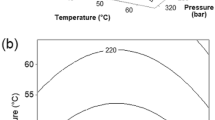Abstract
The root of Korean ginseng, Panax ginseng C. A. Meyer, has been known worldwide as a panacea for many centuries. Contradictory weight gain and loss effects in Korean ginseng led to the adoption of supercritical carbon dioxide extraction to assure the quality of food-grade anti-obesity ginseng products. Among different extraction conditions of CO2 pressure (200 and 300 bars) and temperature (40, 50, and 60°C), the highest extraction yield of 0.66% was obtained with 300 bars at 40°C. To test anti-obesity effect, each supercritical fluid extract (SFE) was supplemented to the high-fat diet of male obese-prone C57BL/6J strain mice. All carbon dioxide SFEs of ginseng showed significant weight-loss effects in the tested mice. The average weights of normal and high fat diet mice were 28.7±2.0 and 35.0±1.6 g, respectively, after 10 weeks. Average weights of mice on SFE-supplemented high fat diets were between 24.5±1.4 and 25.9±1.3 g. SFEs obtained at 50°C, and at both 200 and 300 bars, showed the most profound anti-obesity effect. Both SFEs showed ~15 and ~30% weight loss for the normal and high-fat diet mice, respectively. The major component of the SFE was analyzed as polyacetylene compounds, and panaxydol and panaxynol were identified as major polyacetylene compounds. However, the anti-obesity effect of the ginseng SFEs was not correlated with contents of these two polyacetylene compounds in SFEs. No side-effects of ginseng SFEs were observed, and the anti-obesity effect was reversible.
Similar content being viewed by others
References
Brusselmans K, Vrolix R, Verhoeven G, and Swinnen JV (2005) Induction of cancer cell apoptosis by flavonoids is associated with their ability to inhibit fatty acid synthase activity. J Biol Chem 280, 5636–5645.
Choi SJ, Kim TH, Shin YK, Lee CS, Park M, Lee HS, and Song JH (2008) Effects of a polyacetylene from Panax ginseng on Na+ currents in rat dorsal root ganglion neurons. Brain Res 1191, 75–83.
De Melo, CL, Queiroz MGR, Fonseca SGC, Bizerra AMC, Lemos TLG, Melo TS, Santos FA, and Rao VS (2010) Oleanolic acid, a natural triterpenoid improves blood glucose tolerance in normal mice and ameliorates visceral obesity in mice fed a high-fat diet. Chem Biol Interact 185, 59–65.
Flegal KM, Carroll MD, Ogden CL, and Curtin LR (2010) Prevalence and trends in obesity among US adults. J Am Med Assoc 303, 235–241.
Hirakura K, Morita M, Nakajima K, Ikeya Y, and Mitsuhashi H (1991) Polyacetylenes from the roots of Panax ginseng. Phytochemistry 30, 3327–3333.
Karu N, Reifen R, and Kerem Z (2007) Weight gain reduction in mice fed Panax ginseng saponin, a pancreatic lipase inhibitor. J Agric Food Chem 55, 2824–2828.
Liu JH, Lee CS, Leung KM, Yan ZK, Shen BH, Zhao ZZ, and Jiang ZH (2007) Quantification of two polyacetylenes in radix ginseng and roots of related Panax species using a gas chromatography-mass spectrometric method. J Agric Food Chem 55, 8830–8835.
Matsunaga H, Katano M, Yamamoto H, Fujito H, Mori M, and Takata K (1990) Cytotoxic activity of polyacetylene compounds in Panax ginseng C. A. Meyer. Chem Pharm Bull 38, 3480–3482.
Nho KB and Sohn HJ (1989) Comparative studies on methods of extracting polyacetylene compounds from white ginseng. Korean J Ginseng Sci 13, 198–201.
Park CE, Back NI, and Park CH (2001) Extraction of panaxynol and panaxydol compounds from Korean ginseng. Biotechnol Bioprocess Eng 6, 433–437.
Qian ZM, Lu J, Gao QP, and Li SP (2009) Rapid method for simultaneous determination of flavonoid, saponins and polyacetylenes in Folium Ginseng and Radix Ginseng by pressurized liquid extraction and high-performance liquid chromatography coupled with diode array detection and mass spectrometry. J Chromatogr A 1216, 3825–3830.
Shin BK, Park HY, and Han J (2010) Enzymatic biotransformation of red ginseng and the compositional changes of ginsenosides. J Korean Soc Appl Biol Chem 53, 553–558.
Singh B, Bhat TK, and Singh B (2003) Potential therapeutic applications of some antinutritional plant secondary metabolites. J Agric Food Chem 51, 5579–5597
Author information
Authors and Affiliations
Rights and permissions
About this article
Cite this article
Woo, HC., Shin, BK., Cho, I. et al. Anti-obesity Effect of Carbon Dioxide Supercritical Fluid Extracts of Panax Ginseng C. A. Meyer. J Korean Soc Appl Biol Chem 54, 738–743 (2011). https://doi.org/10.1007/BF03253153
Received:
Accepted:
Issue Date:
DOI: https://doi.org/10.1007/BF03253153




